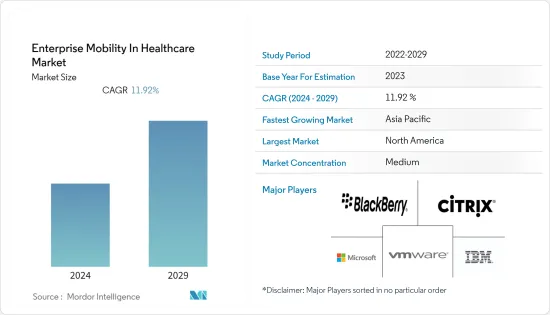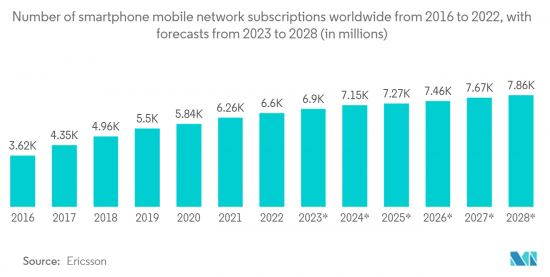PUBLISHER: Mordor Intelligence | PRODUCT CODE: 1403136

PUBLISHER: Mordor Intelligence | PRODUCT CODE: 1403136
Enterprise Mobility In Healthcare - Market Share Analysis, Industry Trends & Statistics, Growth Forecasts 2024 - 2029

The Enterprise Mobility In Healthcare Market is expected to register a CAGR of 11.92% during the forecast period(2024-2029).
Key Highlights
- The healthcare sector is witnessing a remarkable transformation due to mobile technology advancements. With the concerns associated with privacy and security being met effectively compared to earlier, enterprise mobility management (EMM) is witnessing significant adoption in the healthcare industry.
- Factors such as mobile devices being the preferred medium of accessing the internet, enterprise data, and various other information, continuous pressure to cut costs, and the rising trend of bring-your-own-device (BYOD) across numerous healthcare facilities are driving the market growth.
- Various services such as management of mobile devices (tablets, smartphones, or laptops), applications, information, and remote support are provided as a part of enterprise mobility management solutions in addressing the challenges and providing quick and improved decision making, improved treatment, and reduced readmissions, increased productivity, higher accuracy, time and cost-saving.
- The deployment of EMM in healthcare systems enables tackling challenges, such as the traditional way of managing patient records. EMM enables the storage of health records, like prescriptions, lab results, medical history, medications, and more, in a paperless way. This allows quick and easy access to patient health records, allowing the physicians to quickly check a patient's background during emergencies and provide easy information updates.
- However, issues about identity and access management (IAM), which involves granting access to sensitive information only to authenticated sources, could be quite challenging and could pose a security risk. Additionally, the growing adoption of remote patient monitoring systems in the healthcare industry by professionals is expected to fuel the demand growth for Enterprise Mobility in Healthcare Market during the forecast period.
- The COVID-19 pandemic had a significant impact on the healthcare mobility solutions market. As governments and healthcare organizations worldwide grappled with the need to contain the spread of the virus and ensure patient safety, there was an unprecedented demand for remote and contactless healthcare solutions. Therefore, telehealth platforms, remote patient monitoring systems, and mobile applications became essential tools during the pandemic in delivering healthcare services. Furthermore, this surge in demand for remote healthcare solutions led to a significant investment in technology and infrastructure.
- Growing adoption of smartphones and tablets in healthcare systems, rising focus on patient-centric mobility applications, advanced connectivity to enhance the quality of healthcare solutions, better cost efficiency of mobility solutions resulting in a streamlined workflow, shortage of nursing staff and doctors enhancing the adoption of mobility solutions, and robust penetration of wireless networks such as 2G and 3G are factors fuelling the growth of this market. However, data security issues, short battery life of mobile computers, lack of standard communication protocols and reimbursement policies, and infrastructural and cost issues pose major challenges to the growth of the healthcare mobility solutions market.
- The healthcare mobility solutions market is segmented on the basis of products and services, applications, and end users. Based on products and services, the market is segmented into mobile devices, mobile applications, and enterprise platforms. The mobile devices market covers mobile computers, radio frequency identification (RFID) scanners, barcode scanners, and others. On the basis of applications, the market is classified into patient care management, operations management, and workforce management. By end users, the market is divided into payers, providers, and patients.
Enterprise Mobility In Healthcare Market Trends
Growing Adoption of Smartphones In Healthcare Industry As The Preferred Medium of Accessing Information
- In the current scenario, healthcare providers conduct their day-to-day businesses using mobile devices or accessing cloud services. The shift in the industry towards enterprise mobility has resulted in increased employee productivity while using their own devices.
- The proliferation of smartphones has enabled quick and easy patient appraisals due to the presence of different embedded sensors. For example, healthcare providers can access the data from patients' smartphones with healthcare apps to measure heart rates, blood pressure, glucose levels, and more.
- High regional expansion can be attributed to the increasing adoption of advanced mobile technologies and the rising demand for efficient healthcare delivery systems. Additionally, the region's robust healthcare infrastructure, technological advancements, and supportive government initiatives have further contributed to the flourishing market. Moreover, with the continuous advancement of mobile technologies and the growing focus on digital health.
- Besides, mobile health apps eradicate the need to visit a doctor during sickness physically. Eneterpise mobility management (EMM) healthcare solutions offer patients and healthcare providers a convenient way to access care remotely through chat, messages, and video calling. Remote patient care benefits countries and states with low access to healthcare and doctor-to-patient ratios.
- Mobile applications, the Internet of Things (IoT), and wearable devices use APIs to interact with other applications and systems. With real-time API-driven integration, one can make API-centric apps that monitor location, speed, and other parameters on the go.
- Real-time application integration helps data flow between apps in real time and data synchronization across numerous platforms, such as PCs, laptops, and other handheld devices. For instance, According to Cisco, 500 billion devices are expected to be connected to the Internet by 2030
- High regional expansion can be attributed to the increasing adoption of advanced mobile technologies and the rising demand for efficient healthcare delivery systems. Additionally, the region's robust healthcare infrastructure, technological advancements, and supportive government initiatives have further contributed to the flourishing market. Moreover, with the continuous advancement of mobile technologies and the growing focus on digital health.

North America Holds Major Share in the Market
- North America holds a significant share of the healthcare enterprise mobility market. Moreover, the region has a strong foothold on players operating in the market. Some include Cisco Systems, Inc., IBM Corporation, Microsoft Corporation, BlackBerry Limited, and Vmware, Inc., contributing to the market's growth. The vendors operating in the region are collaborating to improve digital transformation solutions further.
- Factors such as government initiatives for digital health, growing demand for better healthcare services, strict regulations regarding patient safety and patient care, and the proliferation of bring-your-own-device (BYOD) drive the growth of the healthcare enterprise mobility market in the region.
- According to IBM Corporation, over 80% of the stakeholders feel smartphones will become an integral part of the healthcare system shortly. Hence, with the growing number of mobile devices in healthcare facilities, the adoption of BYOD is expected to increase in the region. Over the past few years, BYOD has become a leading approach in healthcare settings that allows the implementation of patients' mobile devices in clinical trials and healthcare practice. The adoption of smartphones and tablets for accessing privacy-critical information is expected to drive the region's market over the forecast period.
- Furthermore, healthcare spending in the country is also driving market growth. According to the Bureau of Labor Statistics, the sector employs about 11% of American workers. Such statistics highlight the brimming potential for market growth in the region.
- High regional expansion can be attributed to the increasing adoption of advanced mobile technologies and the rising demand for efficient healthcare delivery systems. The region's robust healthcare infrastructure, technological advancements, and supportive government initiatives have further contributed to the flourishing market. Moreover, with the continuous improvement of mobile technologies and the growing focus on digital health.
Enterprise Mobility In Healthcare Industry Overview
The healthcare enterprise mobility market is moderately competitive, with key players including VMWare Inc., Citrix Systems Inc., IBM Corporation, Microsoft Corporation, SAP SE, and Symantec Corporation consistently engaged in innovation. These companies regularly introduce new products to meet the needs of healthcare providers and maintain their competitive edge. Some recent market developments include:
In February 2022, KORE Group Holdings, Inc., a global leader in Internet of Things ("IoT") solutions and worldwide IoT Connectivity-as-a-Service ("IoT CaaS"), acquired Business Mobility Partners and SIMON IoT. These two industry-leading mobility solution providers were acquired with the intention of expanding KORE Group Holdings' services and solutions within the healthcare and life sciences industries. This strategic move demonstrates the growing importance of mobility solutions in healthcare and the drive to offer comprehensive services in this sector.
Additional Benefits:
- The market estimate (ME) sheet in Excel format
- 3 months of analyst support
TABLE OF CONTENTS
1 INTRODUCTION
- 1.1 Study Assumptions and Market Definition
- 1.2 Scope of the Study
2 RESEARCH METHODOLOGY
3 EXECUTIVE SUMMARY
4 MARKET INSIGHTS
- 4.1 Market Overview
- 4.2 Industry Attractiveness - Porter's Five Forces Analysis
- 4.2.1 Bargaining Power of Suppliers
- 4.2.2 Bargaining Power of Consumers
- 4.2.3 Threat of New Entrants
- 4.2.4 Intensity of Competitive Rivalry
- 4.2.5 Threat of Substitute Products
- 4.3 Assessment of the Impact of COVID-19 on the Market
5 MARKET DYNAMICS
- 5.1 Market Drivers
- 5.1.1 Growth of Mobile Devices as the Preferred Medium of Accessing Internet, Enterprise Data, and Various Other Information
- 5.1.2 Rising BYOD Trend across Healthcare
- 5.2 Market Challenges
- 5.2.1 High Cost of Implementation, Coupled with Lack of Acceptability among Employees
6 MARKET SEGMENTATION
- 6.1 By Solution
- 6.1.1 Mobile Device Management
- 6.1.2 Mobile Application Management (MAM)
- 6.1.3 Mobile Content Management (MCM)
- 6.1.4 Identity and Access Management (IAM)
- 6.2 By Geography
- 6.2.1 North America
- 6.2.2 Europe
- 6.2.3 Asia-Pacific
- 6.2.4 Latin America
- 6.2.5 Middle East and Africa
7 COMPETITIVE LANDSCAPE
- 7.1 Company Profiles
- 7.1.1 BlackBerry Limited
- 7.1.2 Vmware Inc.
- 7.1.3 Citrix Systems Inc.
- 7.1.4 IBM Corporation
- 7.1.5 Microsoft Corporation
- 7.1.6 Mobile Iron Inc.
- 7.1.7 SAP SE
- 7.1.8 Soti Inc.
- 7.1.9 Symantec Corporation
- 7.1.10 Ventraq Corporation
8 INVESTMENT ANALYSIS
9 FUTURE OUTLOOK




